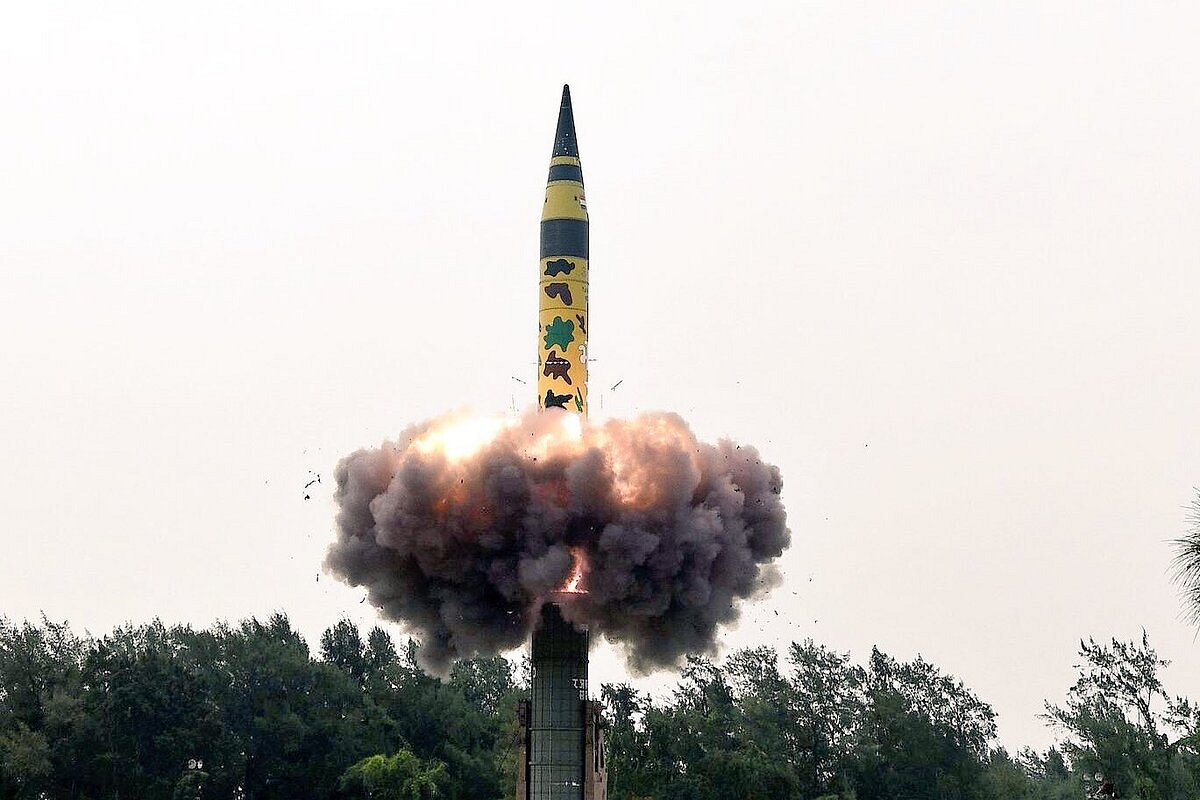Defence
Agni-V MIRVed: Why Capability To Hit Multiple Targets In China With One Missile Matters

Agni-5, a nuclear-capable missile.
India has announced the first flight test of the Agni-5 missile equipped with Multiple Independently Targetable Re-entry Vehicle (MIRV) technology.
The PM, in a post on the social media platform X (formerly Twitter), said, "Proud of our DRDO scientists for Mission Divyastra, the first flight test of indigenously developed Agni-5 missile with Multiple Independently Targetable Re-entry Vehicle (MIRV) technology."
However, India has tested the Agni-5 ballistic missile, capable of striking targets over 5,000 kilometres away multiple times, with the first test conducted in 2012.
So, what is the significance of the MIRV-equipped Agni-5, and why does it matter?
As already stated, MIRV, or Multiple Independently Targetable Re-entry Vehicles capable ballistic missiles, are capable of carrying multiple warheads, each capable of targeting separate locations, vastly enhancing the missile's threat matrix against potential adversaries. This technology contrasts with traditional ballistic missiles, which carry a single warhead.
Take the example of the Russian RS-28 Sarmat, referred to as Satan-II, which is capable of carrying 16 MIRV warheads, giving it the ability to strike 16 different targets.
The strategic implications of deploying MIRV-equipped missiles like Agni-5 are profound.
Not only do they enhance India's offensive capabilities, but they also complicate the defensive strategies of adversaries, read China. These MIRVs can penetrate ballistic missile defences by overwhelming or deceiving them, making it challenging for enemy nations to intercept all incoming warheads.
The high-speed re-entry of ballistic missiles, reaching speeds up to Mach 24, adds another layer of complexity to their interception.
This technological prowess places India among a select group of nations capable of developing advanced missile defense systems, viz, US, France, Britain, Russia, China, Israel, India, and Italy, highlighting the strategic importance of MIRV technology in modern warfare.
Given the high speeds involved in intercepting ballistic missiles, the task is akin to trying to hit a bullet with another bullet.
This requires precision tracking and control of the interceptor missile, especially in near-space conditions where air density is minimal or nonexistent, making maneuvering the missile challenging.
This necessitates the use of a Reaction Control System (RCS), which dramatically increases the costs of the interceptor missiles. Consequently, countries are forced to maintain only a limited number of interceptors in a ready-to-launch configuration.
An RCS is a system that uses four thrusters to precisely control the movement of interceptor kill vehicles.
MIRVs exploit this by launching multiple 'bullets' at once, far more than the defenders can aim at and shoot down. They can overwhelm the defense systems, essentially making the interceptors run out of ammunition, or trick them by mixing in fake targets and electronic signals to create confusion.
This tactic ensures that at least some of the attacking 'bullets' or 'warheads' reach their target, bypassing the BMD system.
That is why MIRV-equipped ballistic missiles are considered destabilizing in nature, tilting the nuclear balance in favor of the MIRV-equipped nation, sparking an arms race with its adversary also trying to come up with MIRV-based missiles.
With this announcement, the Chinese will think twice before getting into a conflict with India, since they understand that India can now target multiple Chinese cities with just one missile, complicating their defences.
First developed by the United States in 1970 followed by the Soviet Union in the late '70s, only five countries in the world have MIRV-capable missiles, viz, the US, Russia, France, Britain, and China.
It is rumored that the Pakistanis have also tested a MIRV-capable missile in 2017 — the Ababeel.
China's DF-5B and CSS-4 are missiles that are capable of carrying MIRV warheads.
Support Swarajya's 50 Ground Reports Project & Sponsor A Story
Every general election Swarajya does a 50 ground reports project.
Aimed only at serious readers and those who appreciate the nuances of political undercurrents, the project provides a sense of India's electoral landscape. As you know, these reports are produced after considerable investment of travel, time and effort on the ground.
This time too we've kicked off the project in style and have covered over 30 constituencies already. If you're someone who appreciates such work and have enjoyed our coverage please consider sponsoring a ground report for just Rs 2999 to Rs 19,999 - it goes a long way in helping us produce more quality reportage.
You can also back this project by becoming a subscriber for as little as Rs 999 - so do click on this links and choose a plan that suits you and back us.
Click below to contribute.
Latest